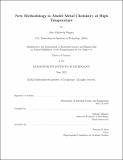New Methodology to Model Metal Chemistry at High Temperature
Author(s)
Wagner, Mary Elizabeth
DownloadThesis PDF (16.71Mb)
Advisor
Allanore, Antoine
Terms of use
Metadata
Show full item recordAbstract
There is currently a lack of ability to predict which species will be reduced at the cathode and what purity will be achieved during metal electrodeposition. Problems related to co-deposition and contamination are usually avoided by using selective aqueous electrolytes or pre-purifying feedstock. However, these approaches are not always possible, particularly when developing novel, high temperature electrochemical processes where there is little experimental information about the electrolyte. In addition, present thermodynamic modeling methods fall short of their ability to accurately predict the properties of the multicomponent, high temperature solutions commonly used for electrolytes. In absence of meaningful models and sufficient data, the standard state electrochemical potential is often used as a metric to determine which reduction reaction will dominate. However, this approach assumes every species in the electrolyte acts as if it were a pure species, and does not accurately reflect true electrochemical behavior.
Herein, a new approach to modeling electrolytes is developed. By examining liquid solutions in a traditional chemical thermodynamic framework, and using this as a foundation for combining targeted experiments with calculated Gibbs energy data, deeper insights into the role of electrolytes on cell behavior can be obtained. A quantitative link between the activity of the electrolyte and the cathode composition is modeled. In order to expand the utility of the model, a new reference state for activity has been derived, specifically suited to the unique challenges of electrolyte thermodynamics. This model was tested against experimental data for several case study systems and performed well at predicting electrochemical behavior. Activity measured relative to the new reference state accurately informed on thermodynamic phenomena. Use of the model on systems with limited data enabled efficient design of new electrochemical processes.
Date issued
2021-06Department
Massachusetts Institute of Technology. Department of Materials Science and EngineeringPublisher
Massachusetts Institute of Technology